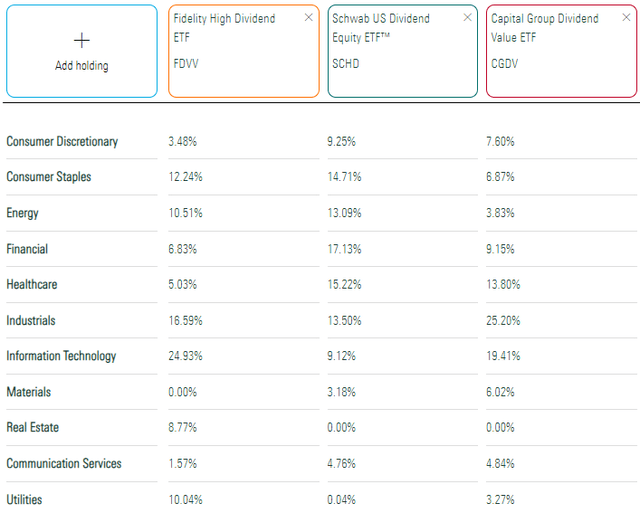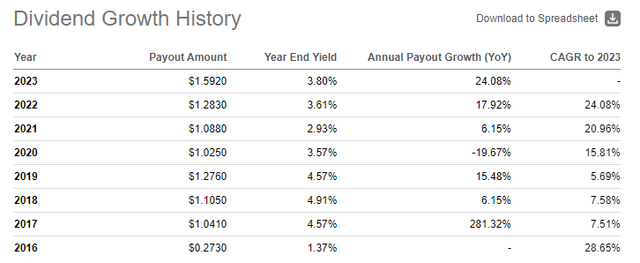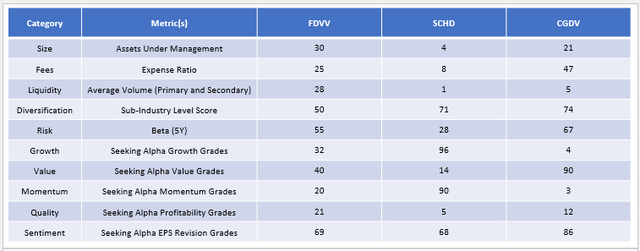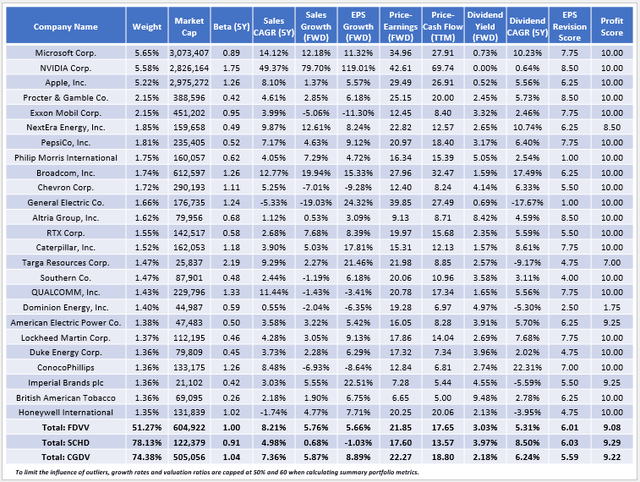Investment Thesis
I last reviewed the Fidelity High Dividend ETF (NYSEARCA:FDVV) on February 27, 2024, where I listed its 3% dividend yield, low P/E, and high quality as reasons for my “buy” rating. Since my initial upgrade on May 28, 2023, FDVV has outperformed the Schwab U.S. Dividend Equity ETF™ (SCHD) by 13.13% and nearly matched the returns of the SPDR® S&P 500 ETF Trust (SPY), an impressive feat for a value ETF in a growth-favored market.
Seeking Alpha
Given these results, you might be concerned about buying at the top. While this is always possible, I’m still comfortable with FDVV because it is well-balanced across nearly every fundamental factor measured. In fairness, its forward P/E is no longer as attractive as in February. Still, it remains one of the more reasonable large-cap value ETFs on the market that delivers enough income to satisfy dividend investors and enough growth to participate in bullish markets. As a result, I’ve decided to maintain my “buy” rating, and I look forward to discussing why in further detail below.
FDVV Overview
Strategy Discussion
FDVV tracks the Fidelity High Dividend Index, selecting roughly 100 securities from the Russell 1000 Index based on three proprietary screens:
- Trailing 1Y Dividend Yield (70%)
- Trailing 1Y Dividend Payout Ratio (15%)
- Trailing 1Y Dividend Growth (15%).
These screens are transparent, but the “proprietary” part relates to how FDVV ranks securities compared to their sector peers. The result is a portfolio with a composition that overweights some low-yielding sectors like Technology. This approach differs from the one employed by SCHD, which has 16% less exposure to Technology.
Morningstar
I’ve also included the sector exposures for the Capital Group Dividend Value ETF (CGDV) to benefit more aggressive value investors. Since March 2022, it’s been the best performer of the three, with a 34.62% total return.
Portfolio Visualizer
Top Ten Holdings
I’ve listed FDVV’s top ten holdings below, which total 29.69%. I expect you’ll be surprised to see Nvidia (NVDA), Microsoft (MSFT), and Apple (AAPL) at the top of the list, as their trailing dividend yields are only 0.71%, 0.01%, and 0.50%, respectively. These will likely never be holdings in SCHD, which only selects from the top 50% of securities by dividend yield.
Fidelity
While this composition is strange for a high dividend fund, what matters most is the Index yield, which is a solid 3.03%. After deducting FDVV’s 0.15% expense ratio, shareholders net 2.88%, 1.03% less than SCHD’s 3.91% expected yield but more than double SPY’s yield.
Dividend Growth Analysis
Before I move into FDVV’s fundamentals, I want to address FDVV’s shrinking dividend yield. It ended 2020 at 3.80%, is now 3.13% on a trailing twelve-month basis, and my 2.88% estimate represents another 0.25% reduction.
Seeking Alpha
If what attracted you to FDVV in the first place were the 24.08% and 17.92% annual dividend growth rates from 2023 and 2022, I suggest you move on, as that won’t happen in 2024. But before you do, understand that a decline in an ETF’s dividend rate does not mean its constituents slashed dividend payments. Consider how FDVV’s share price increased by 21% over the last year ($38.51 to $46.71%), and to maintain the yield, 21% dividend growth is required. This isn’t possible nor responsible in an environment where estimated earnings growth rates are mid-single-digits.
FDVV Fundamental Analysis
Factor Rankings vs. Large-Cap Value ETFs
I want to provide a brief factor review to see how FDVV compares against other large-cap value ETFs, a category that includes 98 funds. As shown, FDVV is well-balanced across the board. Its weakest rank is on sentiment (#69/98), while SCHD and CGDV are relatively weak on growth and value, respectively.
The Sunday Investor
This table also helps explain recent results. CGDV has outperformed because it scores #4/98 well on growth, while SCHD has underperformed for the opposite reason. Using performance charts to decide which ETF is best is tempting, but it’s really a useless exercise. The bottom line is that CGDV will perform well in growth markets, SCHD will perform well in value markets, and FDVV is suitable if you’re uncertain which factor markets will favor moving forward.
FDVV Fundamentals By Company
The following table highlights selected fundamental metrics for FDVV’s top 25 holdings, totaling 51.27% of the portfolio. I’ve also included summary metrics for SCHD and CGDV in the bottom rows.
The Sunday Investor
Here are five observations to consider:
1. FDVV’s weighted average five-year beta is 1.00, placing it above SCHD’s but close to the 0.98 category average. Looking through the holdings, Nvidia, a new dividend payer, is a key contributor to this figure, which is why FDVV will be slightly more risky moving forward. According to Portfolio Visualizer, its historical beta since January 2017 was 0.96.
2. Nvidia boosts risk, but it also contributes to the fund’s well-balanced fundamentals. In particular, analysts expect 79.70% and 119.01% sales and earnings per share growth next year, which I’ve capped at 50% when calculating the portfolio’s 5.76% and 5.66% growth rates. I’ve highlighted these metrics because growth rates are crucial for DGI investors. Without sufficient growth, there’s no way for a company to responsibly grow dividends without either cutting costs or stretching its payout ratio. That’s what happened to SCHD over the last two years, and we must also watch FDVV’s growth rates to avoid getting caught.
3. You might be wondering how SCHD managed to increase dividends in the double-digit range for so long while maintaining a high dividend yield. The reason is that earnings growth rates were enormous for nearly all large-cap funds several years ago. Today, that’s not the case. To demonstrate, I have reverse-calculated historical earnings growth rates for all three ETFs listed above using data from Seeking Alpha.
The Sunday Investor
SCHD’s annualized earnings growth rate for 2021-2022 was 14.36%, which was better than the 13.19% growth rate for the SPDR S&P 500 ETF. As a result, it managed to keep pace with SPY from a total returns perspective and grow dividends at a double-digit rate. However, SCHD’s earnings growth was -8.00% over the last year compared to 16.59% for SPY, and looking at the year ahead, consensus estimates are still negative. In short, SCHD went from a value play with solid growth potential to a value play only. Unlike before, it will only do well if growth stocks fall out of favor.
4. FDVV trades at about a 20% discount on forward earnings compared to SPY (21.95x simple weighted average, 16.58x harmonic weighted average). Even so, it’s on the high end for the large-cap value category, and that is my main criticism today. In February, FDVV featured roughly the same earnings per share growth (5.63%) but traded at 19.52x (17.33x) forward earnings, so there is a greater risk that FDVV is now overvalued.
At the same time, FDVV’s #40/98 value score, derived from sector-adjusted Seeking Alpha Factor Grades, indicates it’s not too bad of a value play. Put differently, FDVV does a decent job selecting value stocks in each sector. However, if Technology stocks crumble, I doubt FDVV will offer much downside protection. Stocks like Nvidia are easy targets, especially if earnings growth rates don’t materialize.
5. CGDV’s constituents yield 2.18% on average, and after subtracting the fund’s 0.33% expense ratio, shareholders should net 1.85% at current prices. It’s not an income play, but its 8.89% estimated earnings growth rate is the best of the three and #3/98 in its category. This metric and its 1.04 five-year beta and 22.27x forward earnings valuation reinforce my earlier conclusion that CGDV is a more aggressive value ETF than FDVV and SCHD. It’s done well recently, but I expect it to underperform in a market drawdown.
Investment Recommendation
The median estimated earnings per share growth rate for S&P 500 Index stocks yielding below 3% is 9.92%, but only 0.53% for those above 3%. This simple statistic tells me high-dividend investors must be extra diligent, as they run the risk of missing out entirely on growth-fueled market rallies for the sake of only marginally higher income. As I mentioned earlier, flat growth for high-dividend stocks wasn’t an issue several years ago, but conditions have changed, and we must adapt.
FDVV solves this growth issue by including lower-yielding stocks like Apple and Nvidia. Its 2.88% expected dividend yield is about 1% less than SCHD’s, but the benefit is a much more balanced portfolio that ranks close to average or better on diversification, risk, value, growth, momentum, quality, and sentiment. By avoiding a poor ranking in any category, FDVV is well-prepared for any market environment, and for those reasons, I’ve decided to reiterate my “buy” rating. I hope you found this information helpful, and I look forward to answering your questions in the comments section below.
Read the full article here



